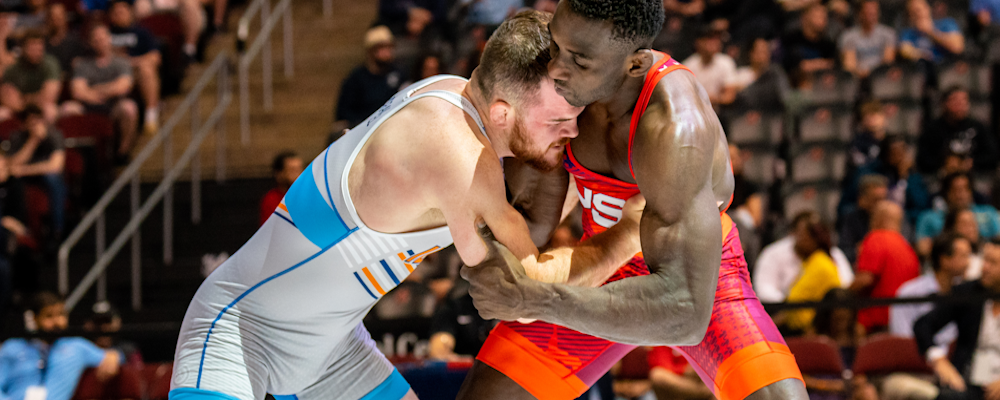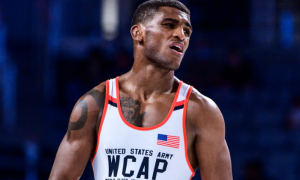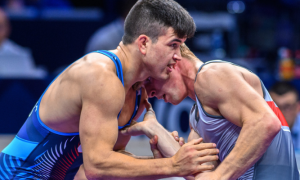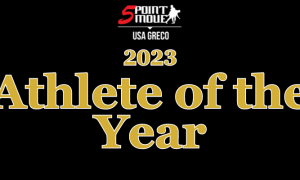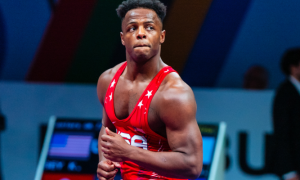On Episode 55 of the Five Point Move Podcast, Zac Braunagel (87 kg, IRTC) did a fine job of detailing the strategy and approach he utilized en-route to defeating three-time National champ Alan Vera (NYAC) last month at Final X: Newark, but there was more to the story pertaining to Braunagel’s triumph on that day in Jersey as well as his overall preparation for the World Team selection process.
Braunagel, 22, hit the ground running, as they say, immediately on the heels of the NCAA Division I National Championships. The ’19 Junior World Team member (and ’18 Fargo Junior titlist) did not allow his concentration to deviate during what was another sparkling but arduous collegiate season. He had placed fourth at the Big Ten Championships, qualified for his fourth NCAA tournament spectacle, and finished with a 25-9 record.
Although Braunagel had previously acquired what is referred to on this platform as “relevant international experience”, questions still surrounded his candidacy leading into the spring Senior Greco-Roman slate of competition. Not only did two-time reigning World Teamer Vera occupy the same weight category, so too did Rich Carlson (Minnesota Storm) and Timothy Young (Army/WCAP), the latter of whom was Vera’s runner-up at Final X a year ago. Then it was confirmed that ’19 World/’20 Olympic Team member John Stefanowicz (Navy RTC) was returning, which further catalyzed the optic that Braunagel might find himself struggling to tread water in a sufficiently deep pool. He had blinders on during the collegiate season, the lot of his adversaries were full-time Greco athletes, and it did not seem as though there might be enough time between the NCAA D1 Nationals and the World Team Trials in May for Braunagel to re-assimilate accordingly.
Doubts might have existed in the minds of casual observers — but they were nowhere to be found in Braunagel’s coach, Bryan Medlin. There was not one time, both prior to the spring and during, when Medlin felt that the hill for his charge was too steep to climb. Even before Christmas break, with the University of Illinois season fully underway, Medlin was convinced that Braunagel would be heard from in a major way once the selection process started to unfold.
But Medlin’s attitude was not one of arrogance or delusional overconfidence. He fitfully believed in Braunagel’s capabilities while maintaining a healthy respect for, and understanding of, the challenges which lied ahead. So, he was calculated. In developing the training plan, the coach geared modalities more towards emphasizing Braunagel’s pre-set strengths while fine-tuning the rhythm under which the athlete should operate. The goal was to rebuild Braunagel’s Greco base without abandoning a brawl-friendly folkstyle influence that could pay dividends against static opposition.
Two others were instrumental in Braunagel’s eventual ascension onto the 2023 US World roster: World Teammate and fellow Illinoisan Joe Rau (97 kg, TMWC) and three-time World rep, Patrick “The Lone Wolf” Martinez (NYAC). Braunagel visited Rau in Chicago, where Martinez had moved after accepting the Wrestling Coordinator position under Mike Powell for Beat the Streets-Chicago. It was difficult to have a more complete training situation than this for Braunagel. He had Medlin, his brother Danny and the rest of his Illinois RTC brethren, and the duo of Rau and Martinez.
In other words, Braunagel drew as much as he could from the resources availed to him and made every minute he spent throughout the entire spring training block count for something. That, coupled with his already immense skill-set and hardcore mentality, is how, and why, he is now getting ready to represent the United States on the World stage come September.
The dialogue below — all of which are Braunagel’s own words — was recorded specifically for this piece.
Zac Braunagel — 87 kg, IRTC
The Training Plan
“With Medlin back here in in Champaign, it had been more focused-training. It was high paced, with high-paced drilling, game-planning, and mindset kind of stuff. When I’m here, I don’t have a lot of Greco partners, at least not right at my weight. That is one reason why I would go to Joe (Rau) and Pat (Martinez), because they were right around my weight; whereas here in Champaign, I’d wrestle with Tanner Farmer, I would do a little bit with Luff (Luke Luffman), and wrestled a lot with Danny, my twin brother. I also wrestled a bit with my little brother, Jo-Jo (Joey). Mainly it was those guys, and I even wrestled once with Coach Ed Ruth. He started grabbing me and I was like, I’m in Greco-mode, man. We started kind of playing around with it and Ed is so creative that he can get by wrestling any style.
“So in Champaign, I wrestled with them and it was more high-paced drilling and getting my cardio up, my muscular endurance up, and, obviously, game-planning. We would work a lot of arm drags and stuff like that, but not super-positionally. It was more about the moves and the pace. This was because I might have partners who were either way bigger than me, or smaller than me. I wrestled a lot with Danny, and here’s a quick story about him. He made me puke in the first couple of matches we wrestled this spring — and that is crazy to me. Danny’s gas tank is way better than mine. He told me something about the U23 Nationals involving Tyler Dow. We’ve known Tyler for years. But at that tournament, Tyler came up to Danny and said, ‘Hey man, you know I’m always cheering for you and I’m always in your corner, but I’m so happy you lost’. So Danny goes, What the heck, man? And Tyler said something like, ‘Yeah, I just didn’t want to wrestle you the next match’. Danny has a reputation for just wearing people down.
“We were making adjustments to work on here with Medlin and strategizing about what we would need to do to win these matches, and also how to incorporate folkstyle into them. You know, stuff like level changes, changing direction… Pulling on the head a little more and putting a pace on these guys. Because, if you watch a lot of Greco, then you know that everyone is in there hand-fighting — but they don’t want to get tired. When they get tired, they start giving up a lot of points. I wanted to keep that folkstyle mindset and use it to my advantage. We worked on this a lot with Medlin up here.
“Then I was up in Chicago and stayed with friends, like Eddie Ordonez and Emery Parker. I also stayed with Joe and we would train par terre defense and offense. It was more positional work and not so much cardio. We worked different positions and play-wrestled in a few areas, do edge drills and stuff like that. We did the front headlock, because Joe’s front headlock is just unreal. I needed a partner and Joe needed a partner, so we got a lot of good work in with each other. We were able to push each other where it was necessary. We did a bunch of matches against one another. Most of them were pretty close. We would both go matches with Pat. Pat has a good lift and I knew that Alan had a good lift, so I did par terre defense with him a lot in order to learn how to defend against Alan’s lift. On the feet, we worked more on little things. For instance, on how to get my shoulder in the right position to push Alan out so that he can’t move and wrestle back in. Pat would show me little things here and there, tips and tricks.
“It was really good to work with the both of them. I went up there and just absorbed knowledge from them because, obviously, they have been doing this for a long time and it was my first time in a couple of years doing Greco. I don’t have as much Greco knowledge as a lot of the guys, especially those who are on the Team now. Picking up tips and tricks from Joe and Pat was huge for me. That is what sparked my growth in Greco over the past two months. It started off with Joe tech’ing me to where, towards the end of it, we were going back-and-forth in a match. It was just that steady, consistent work along with focusing on what I needed to do in order to win. And it worked out.”
How to Translate Folkstyle into Greco
“I think that folkstyle translates pretty well over to Greco in a few aspects. One is that you get a conditioning that is better than freestyle and Greco because folkstyle is all based on control. If you take someone down, now you’ve got to sit there and flex to hold them down. Then if they stand up, you do a mat return and lift them up to bring them back down. It is more conditioning and you get used to it. This translates to Greco well for me because one of my big things is just getting people tired. Once I get people tired, it is a lot easier to score on them. Everyone is going to be strong for the first minute or two. But that’s it, usually. I know that we’re going to behind a little bit with the foreigners on technique, so get them tired and then push, pull, pressure-release.
“Pressure-release is a big part of my folkstyle game. Pressure, pressure, pressure, and create some space and then snap their hands off. It translates well. It might look different in one style compared to another but it’s the same concept. You pressure in with your shoulders, drive with your legs, grab the wrist, get out of the way, and then snap or make them change direction. This transfers over well to Greco, or at least my style of Greco. In college, everyone is out to get you. No one is going to sit there and show you too much respect to do anything to you. I feel like I have seen the opposite thing in Greco. Some guys go out there and respect their opponents too much. I feel like, sometimes, they give too much respect and don’t try everything they know how to do. I went into it this year with a mentality of, I’m coming to win this. I’m not giving them anything, and anything they get will have to be earned. I’m going to make everything a fight.
“Even move-wise, one of the things I was doing this year in Greco was level-changing and faking. I’d grab the guy’s elbow and move it across his body, which is something I would do in folkstyle. I can do that for 20 minutes longer if I’m standing upright, as oppose to folkstyle. That is kind of nice.
“But from where I started, the biggest things are the gas tank and the grittiness. The hard-nosed wrestling that I bring from my blend of folkstyle. It is hard hand-fighting, pulling on the head, and trying to get them tired. Foreign wrestlers do not want to get tired. I wrestled a few of them when I was on the Junior Team (in ’19) and they really do not want to get tired. They shy away from it. They train hard, but in their matches they all fade. And once they fade, they just break down. Folkstyle wrestlers who go into Greco and head overseas better wrestle hard if they want to win.
“I’ve been doing Greco, in total, for about four years, with my first year having been 2016. They are going to know way more than I do overseas. They will be more technically-sound than I am and savvier. But one thing I’ve got in my favor is that I can wrestle a lot harder than they can. That is how I incorporate my folkstyle into Greco.”

Listen to “5PM54: WCAP’s Ryan Epps and a Final X Greco-Roman Preview” on Spreaker.
SUBSCRIBE TO THE FIVE POINT MOVE PODCAST
iTunes | Stitcher | Spreaker | Google Play Music

Notice: Trying to get property 'term_id' of non-object in /home/fivepointwp/webapps/fivepointwp/wp-content/themes/flex-mag/functions.php on line 999

